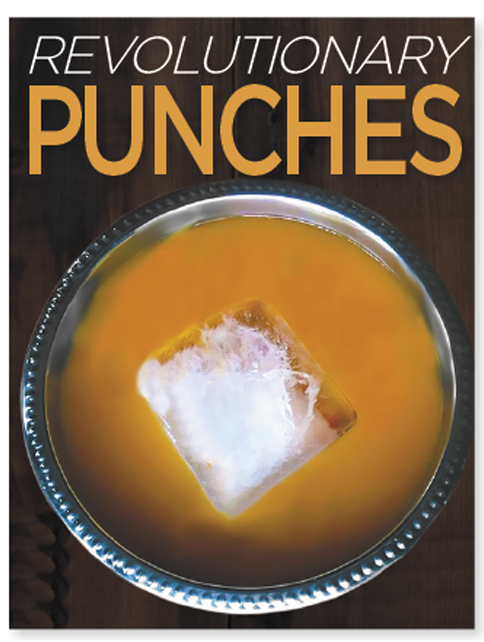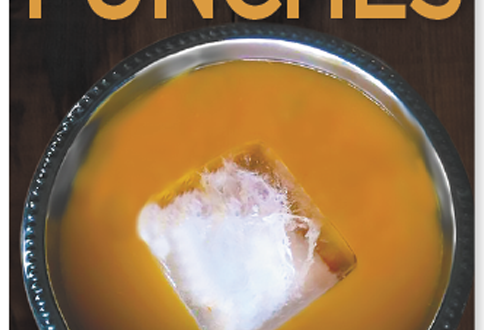REVOLUTIONARY PUNCHES
 By Kirsten Amann
By Kirsten Amann
The Fourth of July is upon us, kicking off the summer party season that we in New England wait patiently for all winter long. Sure, you could fill your coolers with spiked seltzers and sour beers like everyone else at the barbecue this summer. But why not borrow a page from our founding fathers’ recipe book this year? Mix up a bowl of Colonial-era punch and invite your guests to party like it’s 1776!
As we learned in grade school, Massachusetts is the birthplace of the American Revolution. What your fourth grade teacher most likely left out of that history lesson, however, is that the backdrop for many of the momentous events that led to American colonists declaring their independence was, in fact, the barroom. If our rich history seemed a tad boring to your ten-year-old self, I invite you to revisit it from a 21+ perspective now, preferably with an adult beverage in hand.
THE COLONIAL TAVERN In the American colonies, ordinaries (or inns) and taverns were at the center of public life. So, too, were ardent beverages. “Taverns were one of the few places in Colonial Massachusetts where a person could unwind, not only from the stresses of this life but also from thoughts of the next,” writes Stephanie Schorow in Drinking Boston: A History of the City and its Spirits. Colonial life was hard enough, not to mention the constant rhetoric about eternal damnation being bandied about by Puritans — who wouldn’t want to take the edge off with a drink?
The Colonial tavern was where citizens (mostly men) could gather to eat a hot meal, hear the news of the day, and mingle shoulder-to-shoulder with people of different social classes. “After patiently listening to sermons in unheated churches, or attending meetings in the cold expanse of Boston Town House, a large structure used as a seat of government and as a commercial space, citizens would crowd into the warm comfort of taverns, which were built nearby by design,” writes Schorow. These venues weren’t just for drinking, either: they sometimes doubled as spaces to conduct official meetings and legal proceedings. “Thus local drinking establishments were woven into the very social fabric of New England,” writes Schorow, “and were arguably the most numerous public institutions of the Colonial period.”
Colonists were no strangers to strong waters, and in fact drank quite heavily by today’s standards. “Tradition taught, and Americans, like Englishmen and Europeans, universally believed that rum, gin, and brandy were nutritious and healthful,” writes W.J. Rorabaugh in The Alcoholic Republic. “Distilled spirits were viewed as foods that supplemented limited and monotonous diets, as medications that could cure colds, fevers, snake bites, frosted toes, and broken legs, and as relaxants that would ease depression, reduce tension, and enable hardworking laborers to enjoy a moment of happy, frivolous camaraderie.” Alcohol in this period was thus a staple of the Colonial diet, safer in some cases than water, inexpensive because the price of liquor was strictly regulated, and consumed by colonists of all ages, including children. In this period, the annual consumption of hard liquor, per capita, would reach 3.7 gallons, a number that would climb in the post-Revolutionary War period.
BIRTHPLACE OF THE REVOLUTION While these taverns may be long gone today, it is fun to imagine Colonial Americans bar hopping in the areas we know as downtown Boston, the North End, the financial district, and so on. Then, as now, tavern goers would self-select their preferred watering holes based on social class, trade, and of course loyalty to the crown: “the more wealthy, loyalist supporters tended to frequent the British Coffeehouse, an inn and drinking establishment on the north side of what is now State Street, while the more radical-minded drank at the Bunch of Grapes located near the waterfront,” writes Schorow. In his 1917 book Old Boston Taverns and Tavern Clubs, tavern historian Samuel A. Drake describes the Bunch of Grapes tavern as “feelingly referred to by one old traveller (sic) as the best punch-house to be found in all Boston.”
In the decade leading up to July 4, 1776, relationships between Bostonians and the crown had progressively soured, with activism and dissent fomenting in Boston pubs and taverns. “In the fall of 1774 and the winter of 1775, discontent was brewing in Boston over the governance of the British, who were increasingly seen by a certain portion of the population as brutal taskmasters,” writes Schorow. “The dissenters, who would later be called patriots, included Samuel Adams (cousin to John Adams), Paul Revere, John Hancock, James Otis, Dr. Joseph Warren, and Dr. Benjamin Church.” These men, along with many others, were known as the Sons of Liberty, and the Green Dragon was their tavern of choice.
Almost 25O years later, the Green Dragon lives on in local memory as a key location for revolutionary activities. It is known as the staging ground for the Boston Tea Party in 1773, and the pub’s website proudly proclaims itself ground zero for Paul Revere’s famous ride. “In all the local events preliminary to our revolutionary struggle,” wrote Drake, “this Green Dragon section or junto [the Sons of Liberty] constituted an active and positive force. It represented the muscle of the Revolution.”
FEELING PUNCHY So, what were these colonists and activists drinking as they gathered in the tavern to trade hot gossip and dissidence? Many items would have been on offer in this period, including ale, beer, hard cider, bounce, grog, flip, and of course, punch. “For nearly 2OO years, from the 167Os to the 185Os, the Kingdom of Mixed Drinks was ruled by the Bowl of Punch, a large bore mixture of spirits, citrus, sugar, water, and spice,” writes David Wondrich in Imbibe! He describes mixing up a bowl of punch and seeing it through to the end, “come what may” as “a secular communion, welding a group of good fellows in temporary solidarity whose values superseded all others.” Huzzah for bonds made around the punch bowl.
While I can really only speculate that the Sons of Liberty were drinking punch as they planned their political upheaval, the group did choose the punch bowl as a symbol of their camaraderie and activism. In 1768, they commissioned silversmith and member, Paul Revere, to create the piece: “Revere may be best known for his famous ride, but he was a far more skillful artist than horseman,” writes Schorow. “His punch bowl is, however, a masterpiece of elegance. Inscribed with the names of 15 associates of the Sons, it was created as a symbol of how all gathered to drink together in equality.” Today, the punch bowl is in residence at the Museum of Fine Arts.
As you gather round the fire pit this summer, why not mix up a bowl of a bonafide Revolutionary War-era punch? Enthusiasm may have waned for sitting around the punch bowl with a large, uncommitted block of time on one’s hands on your typical weekday, but summer weekends in New England are a totally different thing. If you’re feeling patriotic on the 4th, try the Philadelphia Fish House Punch, which was said to be a favorite of John Adams, as a nice little nod to the Cradle of Liberty, Philadelphia, where Thomas Jefferson famously penned the Declaration of Independence.
PHILADELPHIA
FISH HOUSE PUNCH
Yield 25 servings
8 lemons, peeled
2 1/2 cups demerara sugar
16 ounces boiling water
1 750ml Jamaican rum
12 ounces of VSOP Cognac
12 ounces peach brandy
12 cups cold water
16 ounces fresh lemon juice
Freshly grated nutmeg garnish
1 At least a day ahead, fill a 2-quart bowl with water and freeze until completely solid.
2 In a large punch bowl, muddle the peels from 8 lemons with the sugar.
3 Let the mixture stand for at least 3 hours.
4 Add the boiling water, stirring until as much as possible of the sugar has dissolved. Allow to cool.
5 Once cooled, add the Jamaican rum, V.S.O.P. cognac, peach brandy, cold water and lemon juice and stir to combine.
6 To serve, add the ice block and garnish liberally with freshly grated nutmeg.

